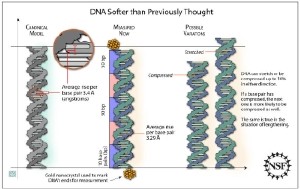Oct 17 2008
The DNA's double helix--the sub-microscopic core of our life--has been the subject of intense study and scrutiny for decades.
 The double helix of DNA has been thought to behave as a stiff elastic rod. However, current research has shown it is much softer than previously thought. The rungs of the DNA's ladder, or base pairs, can compress or elongate, coming up to 10 percent closer or farther apart than the average. Most surprisingly, the scientists found that if a base pair had compressed, the base pairs for at least the next two turns of the double helix were more likely to be compressed as well. Because this study has shown that regions of DNA affect neighboring regions, this might mean that proteins binding to DNA communicate at greater molecular distances than previously thought. Credit: Zina Deretsky, National Science Foundation
The double helix of DNA has been thought to behave as a stiff elastic rod. However, current research has shown it is much softer than previously thought. The rungs of the DNA's ladder, or base pairs, can compress or elongate, coming up to 10 percent closer or farther apart than the average. Most surprisingly, the scientists found that if a base pair had compressed, the base pairs for at least the next two turns of the double helix were more likely to be compressed as well. Because this study has shown that regions of DNA affect neighboring regions, this might mean that proteins binding to DNA communicate at greater molecular distances than previously thought. Credit: Zina Deretsky, National Science Foundation
Observations and measurements at the scale of DNA are tricky. The distance between the rungs in DNA's ladder (or base pairs), for example, was thought to be barely over 3 millionths of a millimeter, or 3.4 Å (angstroms). And this ladder has been typically assumed to be very rigid.
But now a team of Stanford scientists, supported in part by the National Science Foundation, have used a novel molecular ruler to cast doubts on this picture. Using this molecular ruler, they marked each end of a snippet of DNA with electron-dense gold nanocrystals. These markers scattered X-rays directed at the sample differently than the rest of the molecules, and allowed for a more precise calculation.
The observations led the Stanford team to discover that DNA is much softer than previously thought. Variation--both compression and stretching--was observed.
Most surprisingly, the team found that if a base pair had compressed, the base pairs in at least the next two turns of the double helix were more likely to be compressed as well.
These observations have important ramifications for biologists looking at proteins binding to DNA, such as transcription factors regulating gene expression. Because this study has shown regions of DNA affecting the behavior of neighboring regions, it could mean that proteins binding to the DNA could communicate across greater molecular distances than previously thought.